A mall is an expansive building containing numerous stores and services. Additionally, there may be spaces dedicated for entertainment or parking. Therefore, providing adequate fire safety measures at a mall will protect both customers’ lives as well as property in its care.
Shopping malls attract consumers from varying societal classes, nationalities, ages, and socio-economic backgrounds who all possess various needs and desires.
They are a place for entertainmen
Shopping malls are indoor shopping centers that feature large retail areas anchored by multiplex cinemas, food courts and other forms of entertainment such as amusement parks or festivals. Some feature unique architecture to attract customers and tourists.
Contrary to North America, other cultures often have long traditions of gathering in public spaces for meeting, socializing and having fun – something reflected by shopping mall design which includes entertainment and dining components to increase customer traffic and revenue.
Early mall designers modeled new centers after Main Street America, featuring large anchor stores to attract shoppers and smaller “streets” of specialty shops that would benefit from increased foot traffic. This approach represented a radical departure from traditional urban environments and sought to boost sales by creating a more relaxed social experience for customers.
The mall quickly emerged as an unprecedented social center with unprecedented appeal for consumers. Adolescents flocked there to sample the goods so aggressively advertised by advertisers; parents found it an appropriate space for children too restless to remain home alone. Even today, entertainment remains an integral component of mall appeal.
As such, retailers are seeking ways to add attractions and generate additional revenue in malls through retailtainment (a term coined to describe this approach), in an attempt to draw in customers and increase footfall. But retailers must remember they may be missing an essential aspect – creating emotional connections with their visitors.
They are a place for shopping
Shopping malls are large buildings or complexes that house multiple businesses, from shops and restaurants to beauty salons and health clubs. Their unique architecture is one of their primary draws.
Shopping malls have become an indispensable public space in modern society, providing benefits both consumers and owners. An integral component of city development, they provide convenience to shoppers while creating a sense of community in modern urban communities. As opposed to traditional markets, they offer open space and airiness for a comfortable shopping experience that the urban population increasingly depends on.
At that time, shopping malls were designed to meet the needs of urban residents in a new generation. Their developers saw it as an innovative solution that gave them an edge against more traditional market structures; agricultural markets, trementiche markets and shoe markets gave way to modern malls.
Shopping malls may be widely popular, yet they also come with some drawbacks. First of all, they are costly to operate and maintain while being susceptible to changes in consumer tastes and perceived as symbols of consumerism and social stratification.
They are a place for socializing
Modern shopping malls provide an ideal setting for socialization and interaction, drawing together families and friends alike to take advantage of amenities, activities, cinemas, and restaurants available there. However, how people engage socially can vary greatly depending on culture, age, or other factors.
One of the primary advantages of malls is their ability to attract large numbers of visitors, which allows businesses to generate revenue and build brand recognition. Malls also help improve local economies, raise tax revenues, provide safe spaces for young people on weekends when they don’t have an outlet, or simply offer safe refuge from social isolation when necessary.
While Gruen had intended for his malls to mirror the Viennese street life he knew so well, in reality they have not lived up to this vision in many ways. While many modern malls feature pedestrian-friendly designs, most modern malls have become predominantly commercial spaces filled with shoppers and their cars; rendering them inhospitable to pedestrians.
Though malls may seem outdated and defunct today, they continue to draw an impressive crowd of customers each day. Malls serve an important function within communities and help define cultural identities – some even host concerts and other events designed to keep visitors coming back!
They are a place for parking
Shopping malls provide an ideal environment for parking your vehicle, with numerous parking spaces and excellent security measures in place to safeguard its arrival. They also boast food courts where you can share meals with family and friends. It’s essential that there be sufficient parking spots so customers can quickly come and go from the center. In order to attract more shoppers into a mall, customer satisfaction must also be high in order for it to thrive as this increases footfall and ultimately footfall in general.
Malls should increase sales prices by the amount of external costs each shopper imposes on others; in this way, shoppers will internalize any discomfort. At the same time, parking prices should decrease so as to be less than their marginal costs of providing parking spaces; this will encourage more people to use public transit thereby decreasing external costs for other shoppers and making them happier. These examples have been programmed automatically from various online sources and do not necessarily represent the views or endorsement of Merriam-Webster or its editors.
